python自动化运维管理拓扑
1、简介
这部分实验是属于python自动化管理拓扑、配置拓扑的实验。模拟企业配置中,使用python自动化批量管理网络设备,减少人力物力时间成本的场景。
2、实验环境
ensp软件+centos。
ensp中需要配置好cloud,连接本地的vmnet8虚拟网卡,centos需要设置nat。
cloud:
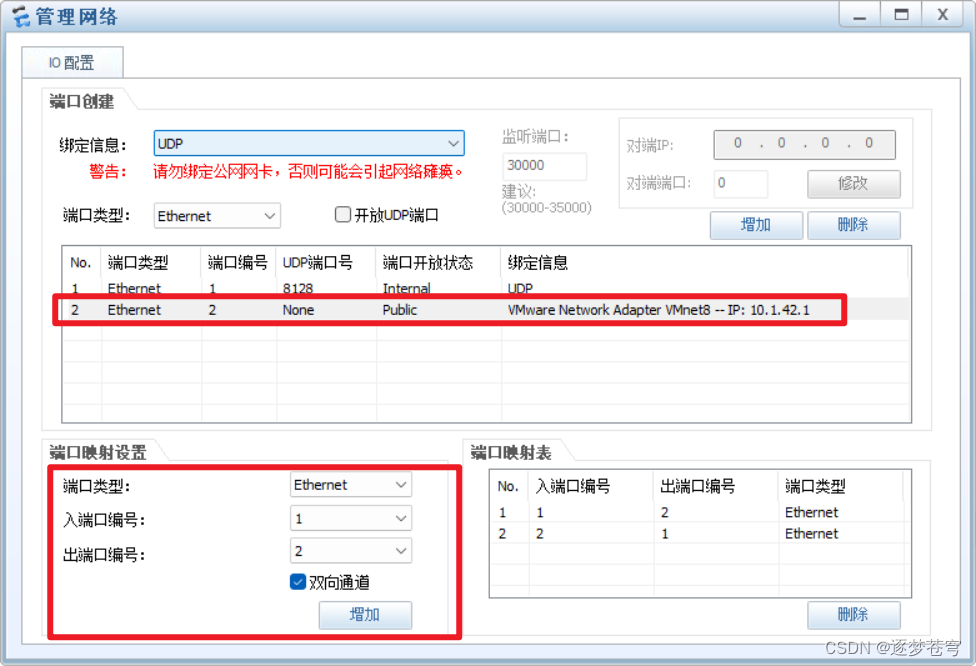
centos8:
centos8需要能ping同vmnet8的网关和拓扑里面的192.168.99.254/24的ip地址。
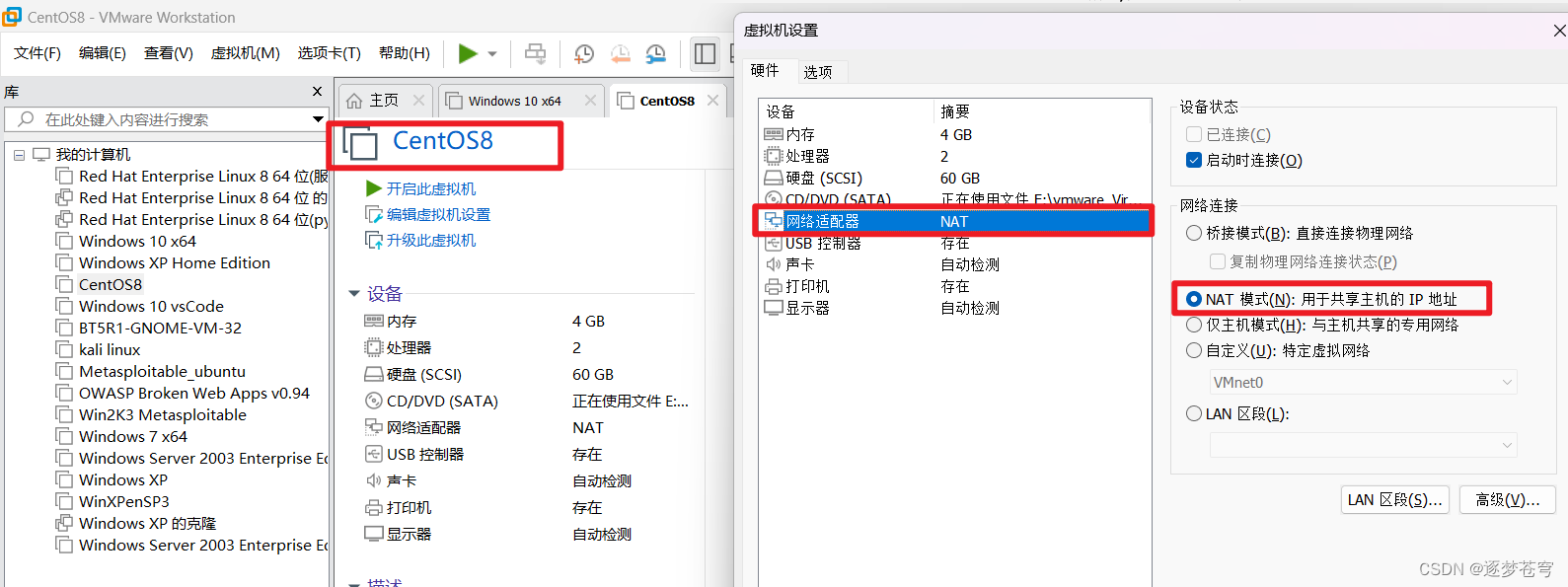

3、拓扑图

4、需求及其代码
4.1、测试连通性
在centos8虚拟机上,测试是否能够ping通实验拓扑中设备(RT、CoreSW1、CoreSW2、AccessSW1、AccessSW2)的管理IP地址:
Ping AccessSW1管理IP地址:

Ping AccessSW2管理IP地址截图:

Ping CoreSW1管理IP地址截图:

Ping CoreSW2管理IP地址截图:

Ping RT 管理IP地址截图:

4.2、远程登陆
远程登陆到设备RT:
代码:
import paramiko
import time
ip = "3.3.3.3"
user = "python"
passwd = "123456"
ssh_client = paramiko.SSHClient()
ssh_client.set_missing_host_key_policy(paramiko.AutoAddPolicy())
ssh_client.connect(hostname=ip, username=user, password=passwd,look_for_keys=False)
command = ssh_client.invoke_shell()
command.send("dis version\n")
time.sleep(1)
output = command.recv(65535).decode("ascii")
name = output.split("<")[-1][:-1]
name = name + "-xzl42"
print(name)
command.send("sys\n")
command.send("sysname " + name + "\n")
time.sleep(1)
command.send("dis ospf routing\n")
time.sleep(1)
output = command.recv(65535)
print(output.decode("ascii"))
ssh_client.close()输出结果:
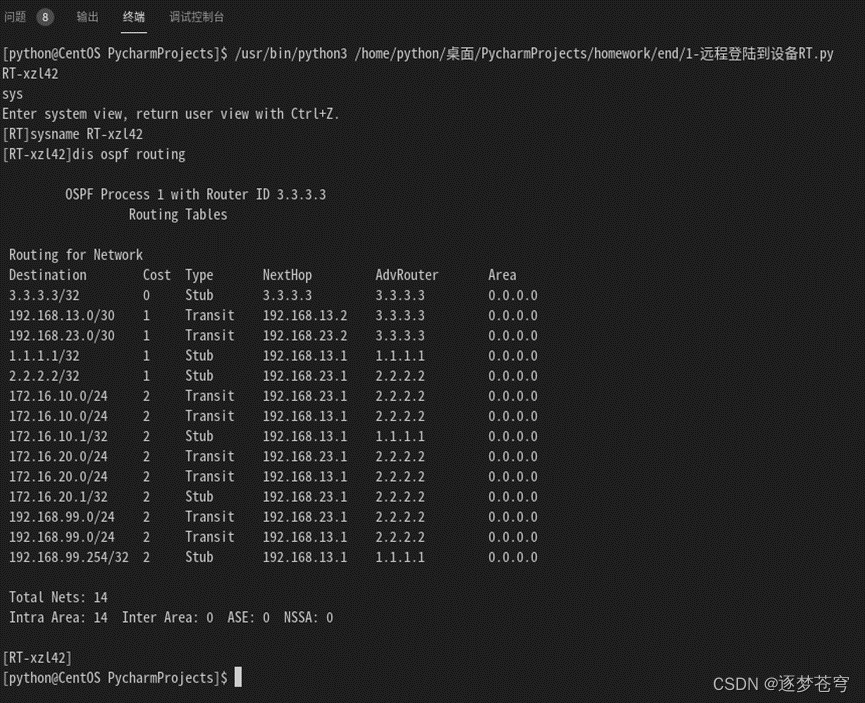
4.3、配置loopback
需求:远程登陆到设备Core SW1和Core SW2上配置loopback42,设置IP地址为92.92.92.92/32并保存配置。并输出该接口的IP配置信息.
代码:
import paramiko
import re
import time
ips = ["1.1.1.1", "2.2.2.2"]
user = "python"
passwd = "123456"
for ip in ips:
ssh_client = paramiko.SSHClient()
ssh_client.set_missing_host_key_policy(paramiko.AutoAddPolicy())
try:
ssh_client.connect(hostname=ip, username=user, password=passwd)
command = ssh_client.invoke_shell()
command.send("screen-length 0 temporary\n")
time.sleep(1)
command.send("sys\n")
command.send("interface LoopBack 42\n")
command.send("ip address 92.92.92.92 32\n")
time.sleep(1)
command.send("display ip interface LoopBack 42\n")
time.sleep(1)
output = command.recv(65535).decode("utf-8")
print(output)
except Exception as e:
print(f"无法连接或配置设备: {str(e)}")
finally:
ssh_client.close()输出结果:
①设备Core SW1输出:
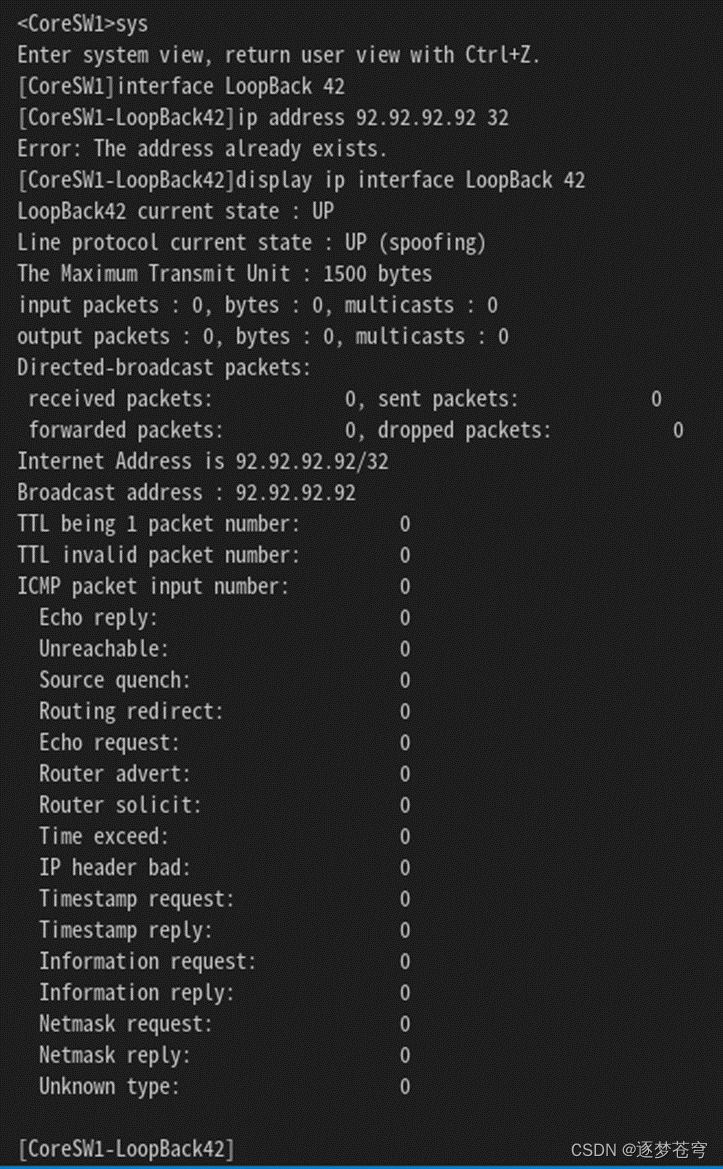
②设备Core SW2输出:

4.4、监控内存使用率
要求:查看实验拓扑中3台设备(RT、CoreSW2、AccessSW2)的内存使用率情况。
这里使用多线程+正则表达式来实现:
代码:
import paramiko
import time
from multiprocessing import Process
import re
def internalStorage(ip):
ssh_client = paramiko.SSHClient()
ssh_client.set_missing_host_key_policy(paramiko.AutoAddPolicy())
ssh_client.connect(hostname=ip, username="python", password="123456")
cmd = ssh_client.invoke_shell()
cmd.send("screen-length 0 temporary\n")
cmd.send("dis memory-usage\n")
time.sleep(1)
result = b''
recv_ready_status = True
while recv_ready_status:
output = cmd.recv(65535)
result += output
time.sleep(1)
recv_ready_status = cmd.recv_ready()
output_end = result.decode("ascii")
name = output_end.split("<")[-1][:-1]
lines = output_end.split("\n")
for line in lines:
result = re.search(r'Memory Using Percentage Is: (\d+)%', line)
if result != None:
output_end = result.group(1)
break
print("{} meory-usage: {}%".format(name,output_end))
ssh_client.close
if __name__ == '__main__':
ips = ["3.3.3.3", "2.2.2.2", "192.168.99.20"]
ls = []
for i in ips:
p=Process(target=internalStorage,args=(i,))
ls.append(p)
for i in ls:
i.start()输出:
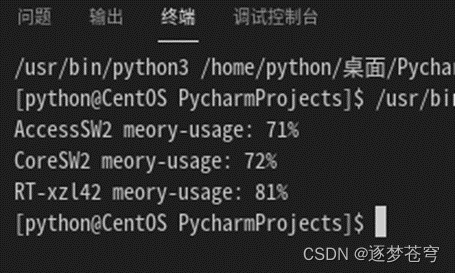
4.5、自动化巡检内存使用率
在4.3的基础上实现对三台设备的自动化巡检内存使用率并输出,每隔20秒巡检一次:
import paramiko
import time
from multiprocessing import Process
import re
def internalStorage(ip):
ssh_client = paramiko.SSHClient()
ssh_client.set_missing_host_key_policy(paramiko.AutoAddPolicy())
ssh_client.connect(hostname=ip, username="python", password="123456")
cmd = ssh_client.invoke_shell()
cmd.send("screen-length 0 temporary\n")
cmd.send("dis memory-usage\n")
time.sleep(1)
result = b''
recv_ready_status = True
while recv_ready_status:
output = cmd.recv(65535)
result += output
time.sleep(1)
recv_ready_status = cmd.recv_ready()
output_end = result.decode("ascii")
name = output_end.split("<")[-1][:-1]
lines = output_end.split("\n")
for line in lines:
result = re.search(r'Memory Using Percentage Is: (\d+)%', line)
if result != None:
output_end = result.group(1)
break
print("{} meory-usage: {}%".format(name,output_end))
ssh_client.close
if __name__ == '__main__':
while True:
ips = ["3.3.3.3", "2.2.2.2", "192.168.99.20"]
ls = []
for i in ips:
p=Process(target=internalStorage,args=(i,))
ls.append(p)
for i in ls:
i.start()
time.sleep(20)4.6、自动化配置snmp服务
需求:通过python脚本,在设备CoreSW1上配置snmp服务,只允许win10-vscode作为网管平台访问其snmp服务:
代码:
import paramiko
import time
from multiprocessing import Process
def sshLogin(ip):
ssh_client = paramiko.SSHClient()
ssh_client.set_missing_host_key_policy(paramiko.AutoAddPolicy())
ssh_client.connect(hostname=ip, username="python", password="123456")
cmd = ssh_client.invoke_shell()
try:
cmd.send("sy\n")
cmd.send("acl 2000\n")
cmd.send("rule 5 permit source 192.168.99.101 0.0.0.0\n")
time.sleep(1)
cmd.send("rule 100 deny\n")
cmd.send("quit\n")
cmd.send("dis acl all\n")
cmd.send("snmp-agent\n")
time.sleep(1)
cmd.send("snmp-agent community read pub-xzl-42 acl 2000\n")
time.sleep(1)
cmd.send("snmp-agent community write prv-xzl-42 acl 2000\n")
time.sleep(1)
cmd.send("snmp-agent sys-info version v1 v2c\n")
time.sleep(1)
cmd.send("dis snmp-agent community\n")
output = cmd.recv(65535).decode("utf-8")
print(output)
except:
print("出错")
ssh_client.close()
if __name__ == '__main__':
ips = ["1.1.1.1"]
ls = []
for i in ips:
p=Process(target=sshLogin,args=(i,))
ls.append(p)
for i in ls:
i.start()输出:
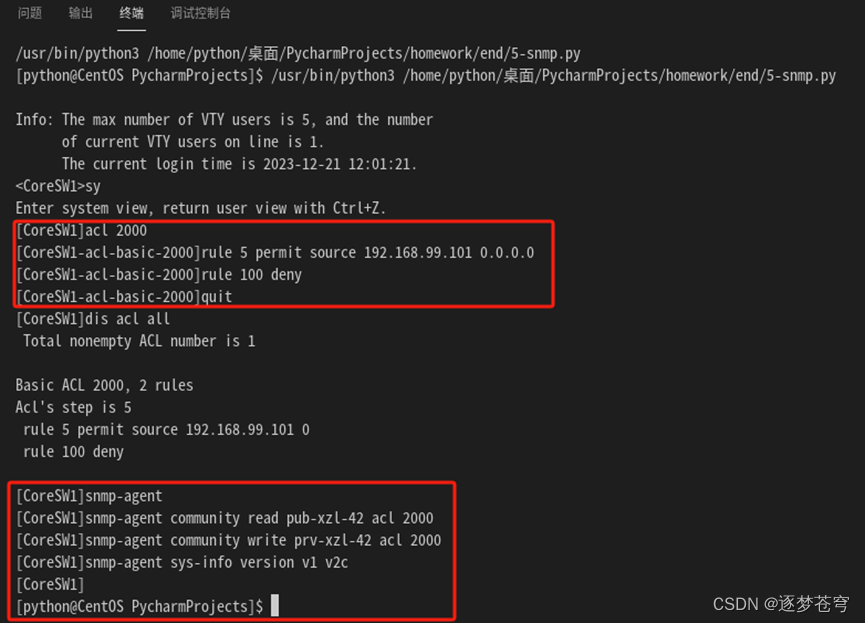
测试snmp服务正常,开启抓包抓取到平台获取到的system组信息:

抓包截图:

4.7、提取分析字符串
从如下字符串中提取相应信息并保存到json文件,读出保存的json文件并打印出来。
字符串:
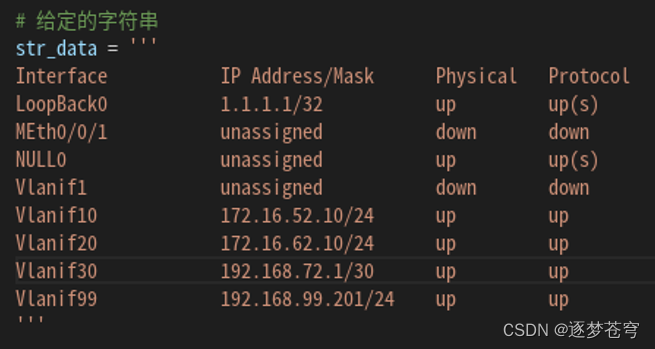
代码:
import re
import json
def convert_prefix_to_subnet_mask(prefix):
# 将子网掩码的位数转换为字符串
subnet_mask = '1' * prefix + '0' * (32 - prefix)
# 将字符串转换为四段十进制数字
octets = [int(subnet_mask[i:i+8], 2) for i in range(0, 32, 8)]
# 将数字转换为点分十进制格式
subnet_mask_str = '.'.join(map(str, octets))
return subnet_mask_str
# 给定的字符串
str_data = '''
Interface IP Address/Mask Physical Protocol
LoopBack0 1.1.1.1/32 up up(s)
MEth0/0/1 unassigned down down
NULL0 unassigned up up(s)
Vlanif1 unassigned down down
Vlanif10 172.16.52.10/24 up up
Vlanif20 172.16.62.10/24 up up
Vlanif30 192.168.72.1/30 up up
Vlanif99 192.168.99.201/24 up up
'''
# 提取接口信息的正则表达式
interface_regex = re.compile(r'(\S+)\s+([\d.]+(?:\+\S+)?)/(\d+)\s+\S+\s+\S+')
# 提取接口信息
interface_matches = interface_regex.findall(str_data)
# 创建 JSON 数据
json_data = {
"文件描述": "本json文件保存网络设备接口IP信息",
"创建者": "xzl42",
"接口IP信息": [{"接口名": name, "IP地址": ip, "子网掩码": convert_prefix_to_subnet_mask(int(prefix))} for name, ip, prefix in interface_matches]
}
# 将 JSON 数据保存到文件
with open('jsonData.json', 'w', encoding='utf-8') as json_file:
json.dump(json_data, json_file, indent=4, ensure_ascii=False)
# 读取 JSON 文件并打印
with open('jsonData.json', 'r', encoding='utf-8') as json_file:
loaded_data = json.load(json_file)
print(json.dumps(loaded_data, indent=4, ensure_ascii=False))输出:
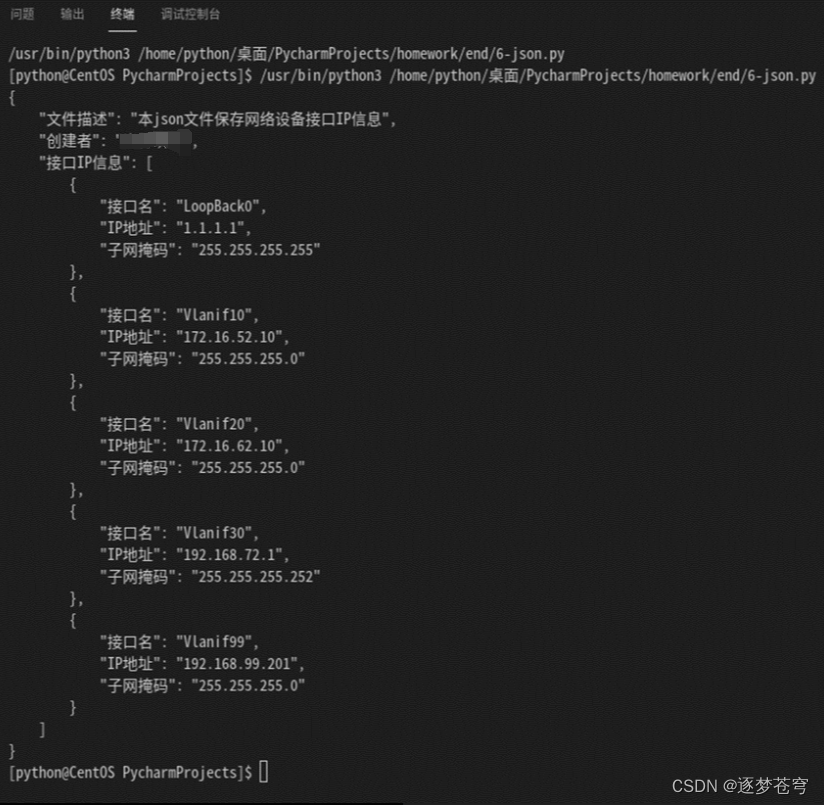
json文件:
{
"文件描述": "本json文件保存网络设备接口IP信息",
"创建者": "xzl42",
"接口IP信息": [
{
"接口名": "LoopBack0",
"IP地址": "1.1.1.1",
"子网掩码": "255.255.255.255"
},
{
"接口名": "Vlanif10",
"IP地址": "172.16.52.10",
"子网掩码": "255.255.255.0"
},
{
"接口名": "Vlanif20",
"IP地址": "172.16.62.10",
"子网掩码": "255.255.255.0"
},
{
"接口名": "Vlanif30",
"IP地址": "192.168.72.1",
"子网掩码": "255.255.255.252"
},
{
"接口名": "Vlanif99",
"IP地址": "192.168.99.201",
"子网掩码": "255.255.255.0"
}
]
}??????????????
本文来自互联网用户投稿,该文观点仅代表作者本人,不代表本站立场。本站仅提供信息存储空间服务,不拥有所有权,不承担相关法律责任。 如若内容造成侵权/违法违规/事实不符,请联系我的编程经验分享网邮箱:chenni525@qq.com进行投诉反馈,一经查实,立即删除!
- Python教程
- 深入理解 MySQL 中的 HAVING 关键字和聚合函数
- Qt之QChar编码(1)
- MyBatis入门基础篇
- 用Python脚本实现FFmpeg批量转换
- k8s搭建(一、环境配置与docker安装)
- 【广州华锐互动】VR科技科普展厅平台:快速、便捷地创建出属于自己的虚拟展馆
- 几本学习中整理和面试的PDF,以及精选面试资料
- 10 个 Kubernetes 最佳实践(规划和设置)
- SpringIOC之support模块DefaultMessageSourceResolvable
- 学习python仅此一篇就够了(使用python操作数据库)
- RSA加密解密——用shell加密java解密
- 【漏洞复现】CloudPanel makefile接口远程命令执行漏洞(CVE-2023-35885)
- 花为缘享奢奢侈品创业开启奢侈品行业高质量发展之路
- 【PHP】TP5使用orderRaw 方法设置排序规则